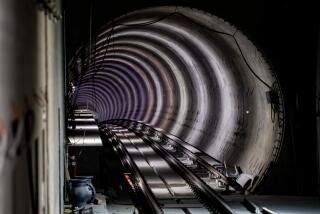Timeline for the Red Line
A look at milestones on the Metro Rail subway project:
1980
* Los Angeles County voters approve Proposition A, a half-cent sales tax for transit improvements.
1983
* President Reagan signs a transportation bill that provides $117.2 million for the start of construction.
1985
* A cloud of methane gas seeps into the basement of the Ross Dress for Less store at 3rd Street and Fairfax Avenue, causing an explosion that injures 21 people.
1986
* Congress blocks use of federal funds and declares part of the Wilshire Corridor too hazardous for tunneling because of underground methane concentrations. A new subway route must be selected.
* Ground is broken at 1st and Hill streets for the first of five stations along the 4.4 miles of Segment 1, which begins at Union Station and ends at MacArthur Park.
1987
* Construction begins. Problems related to contaminated ground water and land acquisition delay work for almost six months.
1988
* Discovery of contaminated soil at Union Station forces realignment and delays construction again.
1989
* A new subway route is selected that will travel north under Vermont Avenue and west on Hollywood Boulevard.
1990
* L.A. County voters narrowly approve Proposition C, which adds another half-cent transit sales tax.
1991
* To avoid pockets of methane, a Mid-City route is selected that would stretch along Wilshire to Crenshaw Boulevard, then to Pico and San Vicente boulevards.
1992
* Tunneling starts on the Hollywood line.
1993
* The first 4.4-mile segment of the subway opens.
* The Metropolitan Transportation Authority is created by the merger of the Southern California Rapid Transit District and the county transportation commission.
* Water leakage causes millions of dollars in damage to the subway because a costly protective liner was poorly designed, installed and inspected.
1994
* Tunneling begins on the 6.3-mile segment extending from Hollywood and Vine to Universal City and North Hollywood.
* An independent tunnel panel reports that it found lax enforcement of construction requirements, along with previously undiscovered areas of thin concrete, air pockets and missing reinforcing steel in the tunnel wall. But it says the tunnels are safe.
* Transit officials acknowledge that nearly one-third of the subway tunnels under construction between downtown and Hollywood are misaligned and that some segments will need to be re-excavated.
* Tunneling beneath Hollywood Boulevard is shut down after the street buckles and sinks, damaging buildings.
* The Federal Transportation Administration announces that federal funding for the subway will be withheld until questions regarding mounting construction and management problems are resolved.
1995
* In the subway project’s worst setback, a 70-foot-wide sinkhole opens on Hollywood Boulevard, sending 20 workers scrambling for their lives.
1996
* Two digging machines, nicknamed Thelma and Louise, begin boring through 2.4 miles of the Santa Monica Mountains from Universal City to Hollywood.
* A 2.1-mile extension of the subway opens with three new stations on Wilshire Boulevard at Vermont, Normandie and Western avenues.
1997
* Digging machines complete boring twin subway tunnels from the San Fernando Valley to Hollywood.
1998
* Facing financial trouble, the MTA board halts work on subway extensions to the Eastside and Mid-City and a light rail line to Pasadena.
* L.A. County voters approve a ballot measure that bans the use of the transit sales tax for any more subway construction beyond North Hollywood.
1999
* Five stations along 4.6 miles of new subway from Wilshire and Vermont to Hollywood and Vine open to passengers.
2000
* Ridership on the subway system is less than the MTA predicted.
* The last 6.3 miles of subway from Hollywood and Highland station to Universal City and North Hollywood are set to open on June 24.
Researched by CECILIA RASMUSSEN / Los Angeles Times
More to Read
Sign up for Essential California
The most important California stories and recommendations in your inbox every morning.
You may occasionally receive promotional content from the Los Angeles Times.










